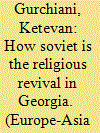| Srl | Item |
| 1 |
ID:
154372


|
|
|
|
|
| Summary/Abstract |
This article explores everyday religiosity in post-Soviet Georgia based on multi-sited fieldwork and applying a genealogical approach. It looks at the use of tactics in negotiations between priests and believers. The article sees negotiations, prevalent in domestic religiosity and embodied practices, as a continuation of everyday Soviet tactics, particularly informal networks (Blat) and moonlighting (Khaltura). To understand how negotiations lead to greater control and an increase in religiosity, the article explores important features of the Georgian Orthodox Church and its specific development. The article concludes that tactics in this specific context strengthen the more powerful and reproduce dependency.
|
|
|
|
|
|
|
|
|
|
|
|
|
|
|
|
| 2 |
ID:
191074


|
|
|
|
|
| Summary/Abstract |
Focusing on the domestication and undomestication of nature around the River Vere in Tbilisi, Georgia, this article analyses how modernization projects seemingly overcoming nature simultaneously reinforced the complex entanglement between nature and infrastructure, the material and immaterial, the human and non-human. The article centres around a flooding event in 2015, shedding light on the entanglement of different approaches and temporalities. The river and its infrastructure are caught up with ideas, beliefs and materialities. The paper analyses how the crisis gave rise to questions about ‘morality’ of materiality, ‘proper’ and ‘improper’ handling of nature. Based on ethnography and archival work, it shows how the infrastructural developments conceived as projects of Soviet atheist modernity emerged as sites where nature, technologies and religion meet. Rather than looking at Soviet and post-Soviet as two different modernities, the article shows them as continuities.
|
|
|
|
|
|
|
|
|
|
|
|
|
|
|
|